Acer T232HL - Touch Comes to the Desktop
by Chris Heinonen on February 6, 2013 9:00 AM ESTColor Quality and Gamut
Straight out of the box, the best numbers that the Acer can produce on our Gretag Macbeth test are pretty poor. The average dE is over 8, and the grayscale numbers are the worst that I’ve measured. The only shade even close to being an ideal number is yellow, with everything else having an error of 5 or above.
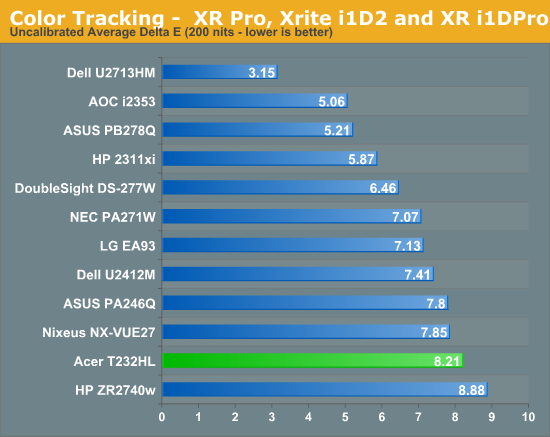
For our calibration tests we use ColorEyes Display Pro, an i1Pro meter, and we target 200 nits of light output, a gamma of 2.2, a white point of D65, and the minimum black level we can hit. Any adjustments that we can make in the monitor to correct white balance or colors are done before the calibration, and the best starting mode is used. I always try calibrations with and without DDC enabled in ColorEyes Display Pro, but haven’t run into a result in a long time where hand tuning it was better than using DDC; they are usually identical.
After calibration, the Acer is really improved. The grayscale has gone from abysmal to very accurate, and the remaining flaws are in shades of blue that almost always cause monitors trouble. If you care about color quality, you really do need to calibrate the Acer as without a calibration, the colors are just far from ideal.
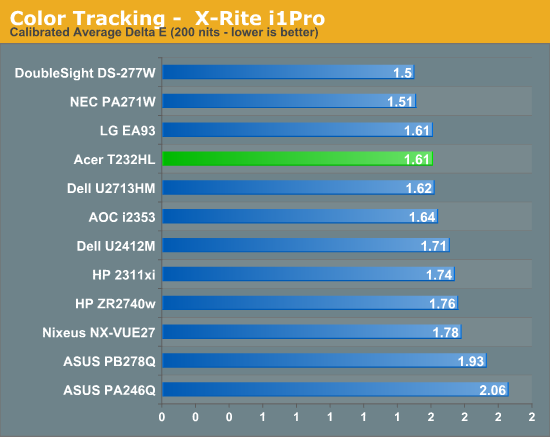
After that calibration we target 100 nits, which is more likely to be used with print or paper work than with on screen design work. We don’t get quite as good of results here, and the grayscale error is a good bit higher than before as well. It isn’t poor, but it’s not as good as other monitors can do, but this display also isn’t targeted towards print professionals.
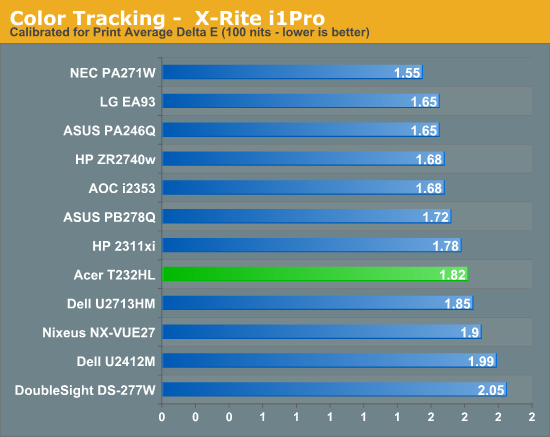
So we have really poor initial color, very nice post-calibration color, and so-so calibration color for print work. If you really care about color quality then you’re going to want to calibrate it, and even if you don’t the level of error is high enough that it might be a bit distracting, especially since the grayscale is so bad.
The gamut is supposed to be sRGB and here it comes up just a little bit short. We look for 71% of AdobeRGB to be equal to sRGB, but we only get 68% of the AdobeRGB gamut here. This also comes in near the bottom of the monitors recently reviewed, and isn’t too unexpected due to the LED lighting which often falls short.
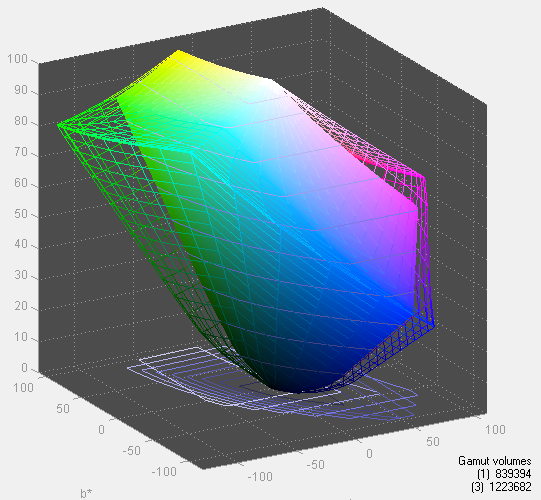



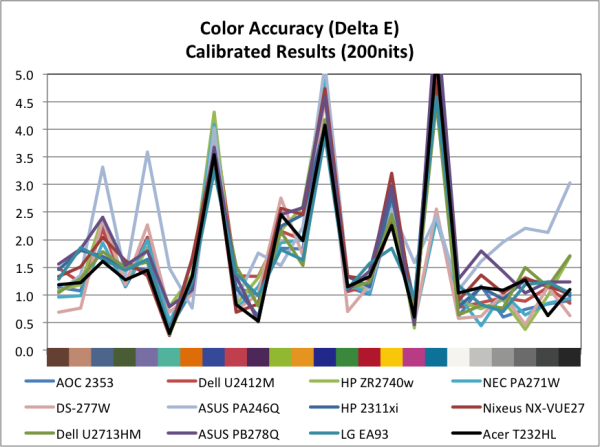









66 Comments
View All Comments
pandemonium - Wednesday, February 6, 2013 - link
The only way I can use a touchscreen for a desktop computer will be with a drawing table layout with the screen actually in the desk. *patent!!*Operandi - Thursday, February 7, 2013 - link
Bring on 4K IPS/VA panels and stop making worthless crap.Dribble - Thursday, February 7, 2013 - link
It just doesn't work. You want your arms relaxed in front of you - hence the design for mice + keyboards.Where touch screens work you tend to be looking down at them and have them close to your body so you arms stay relaxed. This is not the case for a desktop monitor - you cannot keep your arms vertically out in front of you for any length of time - it's very tiring.
Hence the whole concept is flawed which anyone with half a brain could have told MS/Acer.
Beaver M. - Thursday, February 7, 2013 - link
Exactly. Though I can imagine, that a hype would press it anyway. Doesnt matter that spine and arm problems will skyrocket after that.TheGreenFoX - Thursday, February 7, 2013 - link
If you have a primary gaming screen with a fullscreen game on, and a touch screen with the metro interface as 2. screen - will the game minimize if you make a touch input on the touchscreen, or can you use the metro apps without minimizing the game?chaoticlusts - Thursday, February 7, 2013 - link
Will be interesting too see how the interface devices due out this year compare with touch screen desktop monitors for convenience.I don't really see touch on a desktop screen being very convenient for most people unless you rearrange your setup around it... and even then it would hard not to be awkward. Touch works great on laptops and smaller devices but I really think if people want the 'hands on' approach with desktops things like Leap Motion or the Kinect 2 will take off rather than products like this. even more so when it means adding a $100 device rather than paying hundreds extra for a touch monitor.
beck2050 - Thursday, February 7, 2013 - link
Touch my screen on a desktop is uncomfortable and unacceptable for me.I would never want a touchscreen there.
ypsylon - Friday, February 8, 2013 - link
It is really one environment where touch screen is nothing more than a nuisance. Imagine situation like this.You have a desk, on a desk is LCD 27"-30". LCD is standing as it should ~50-60 cm from user so his/her eyes won't bleed after 10 seconds. How the hell somebody thinks (Microsoft for that matter) that user will sit even closer, virtually next to a big LCD pushing buttons on the screen. Really laughable idea. Imagine writing something in the office or doing really complicated spreadsheet just with virtual keyboard stretching you arms across the desk. And if user must keep his/her beloved keyboard and mouse because nobody else on the market cares about touch screen software then idea of a touch screen for desktop is as dead as ISA slot on motherboards.
There are environment where touch screen is used for ages: manufacturing, finances (stock exchange), military, engineering and so on. For now home-desktop area is a no-go zone. We haven't exactly reached Star Trek level of computerization where with few taps on a pad you can run a starship. :D
JimmiG - Friday, February 8, 2013 - link
The whole reason Apple went with touch on the first iPhone was to get the most effective use of the limited screen real estate and surface area of a phone.It is *not* the best interface for large screens or desktop computers where a mouse and keyboard is available. This silliness needs to go away.
DagB - Friday, February 8, 2013 - link
Comments like this really bugs me, especially on a site like this... Where is the forward thinking? Do you actually think people will sit with a mouse and keyboard in 20 years to the same extent they do today? There are lots of interesting things happening; touch, motion sensors, haptic technologies and so on. I agree that this is probably not an optimal interface if you mainly type or do normal "office" work. But there are people doing other stuff as well on there desktops. For example all types of "creative" activities (film editing, photo editing, music producing etc).For me as a music producer this is something really interesting, that has the potential to totally change the way we produce, mix, create and edit music. Ipad is way to small/limited for more advanced work, but is still very interesting. If you put a large desktop screen (more) horizontally, you will not get tired after hours of work and would have all the real estate you need. Also, that is the work position producers and sound engineers have worked for decades. I hope this is just the beginning of a change to a more intuitive and "direct" way of interacting with our digital tools. We should embrace it!